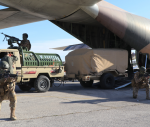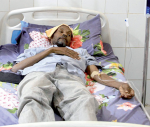You are here
Climate safety nets for all
Apr 10,2021 - Last updated at Apr 10,2021
LONDON — As preparations for this year’s COP26 climate summit in Glasgow intensify, attention is focused on efforts to prevent a future catastrophe. But real-time climate catastrophes already are playing out in the lives of millions of the world’s poorest and most vulnerable people. What will COP26 offer them?
Stick a pin in a map of global humanitarian emergencies, and you will most likely land on a crisis that has been caused or aggravated by droughts, floods and storms. In 2019, extreme weather events pushed more than 34 million people into hunger and food insecurity. In the 55 countries with food-insecurity crises, 75 million children under the age of five are chronically undernourished and face higher risks of diarrhea, pneumonia, and other killer diseases that accompany droughts and floods.
Save the Children is responding to these emergencies. In the Horn of Africa, our nutrition programmes are treating the children of farming families devastated by successive droughts, floods and the worst desert locust infestation in a generation. In the Sahel region, we are working with communities hit by drought and displaced by increasingly deadly conflicts over water. But humanitarian efforts are being overwhelmed by the scale of the crisis, and worse is to come.
COP26 is one of our last opportunities to lock in the measures needed to keep temperatures within the 1.5º-2ºC ceiling set in 2015 by the Paris climate agreement. But even 1.5ºC of warming would have disastrous implications for poverty and malnutrition in the poorest countries. The evidence from climate science points overwhelmingly towards less predictable rainfall, more extreme, frequent and protracted droughts, and more destructive storms. Meanwhile, the World Meteorological Association anticipates a long-term decline in food productivity in Africa, the world’s most food-insecure region.
Rich countries are already investing heavily in adapting to climate-change threats. When disasters strike, their citizens can fall back on elaborate safety nets, well-financed health systems, and insurance policies covering loss and damage to assets. Flood defenses are being strengthened across Europe, and America’s current Farm Bill includes a $39 billion federal insurance programme to protect heavily subsidised producers against crop losses.
Contrast that with the situation facing Africa’s farmers. When extreme weather events destroy crops, kill livestock, and drive up food prices, families cope by cutting meals and reducing spending on health and education. Lacking insurance and savings, the poorest households are forced to sell off productive assets, including livestock, effectively closing their route to recovery. Livestock losses during Somalia’s 2016 drought cost the country’s farmers an estimated $2 billion — an extraordinary loss for some of the world’s poorest people.
The international community’s preferred first-line response to climate disaster is to provide humanitarian aid. That aid saves lives, but the current system invariably delivers too little, too late. Last year, donors provided only half of the funding requested by the UN, a record gap. And much of the aid arrived long after the most vulnerable families had already been forced to cut food consumption, withdraw children from school and sell assets.
There is a better way to support the world’s most vulnerable populations. Three years ago, I met women pastoral farmers in Wajir, an arid area in northern Kenya, in the aftermath of a devastating drought. They had managed to avoid cutting meals for children or selling off their livestock because they were receiving cash through Kenya’s Hunger Safety Net Programme. As soon as the drought struck, early payments were automatically triggered (based on rainfall data).
Well-designed safety nets succeed where humanitarian aid often fails, because they catch vulnerable people as soon as they start to fall, instead of waiting until they hit the ground; thus, they provide a springboard for recovery. There is abundant evidence from the Sahel, the Horn of Africa, and other regions that small cash transfers improve nutrition, increase investment, and boost crop production, especially when targeted to women. And these programmes can respond rapidly to a crisis. During the 2017 drought, Ethiopia’s safety net was extended to reach an additional 3 million people.
Early action is the key to rapid recovery. Every dollar invested in recovery during the first few weeks of a drought in the Horn of Africa can save poor farmers $50 in lost income and assets four months later. When linked to early-warning systems, safety nets can also provide a platform for crisis prevention. In Bangladesh, vulnerable households were provided grants ahead of anticipated flooding, enabling them to relocate. Beyond saving lives and protecting assets, the programme reached twice as many people as a previous humanitarian response had, and at half the cost.
Targeted safety-net programmes could offer an efficient and equitable way to build resilience against climate change. Unfortunately, they are currently weakest where they are most urgently needed. Fewer than one in five people in low-income countries are currently covered; and in Africa, safety nets are chronically under-financed, fragmented, and poorly equipped to address the critical challenge of responding to child poverty and malnutrition.
At COP26, world leaders should task the World Bank and the United Nations with developing a strategy to reach the 155 million people facing food-insecurity crises, and to prioritise children in safety-net design.
Increased finance will be crucial, especially given the post-pandemic fiscal constraints that many developing countries now face. The G-7 has already agreed in principle to authorise a new allocation of the International Monetary Fund’s reserve asset, special drawing rights (SDRs). Reallocating these funds to the poorest countries would go a long way toward creating the fiscal space to invest in safety nets. So, too, would additional debt relief and the $25 billion in new funding proposed by the World Bank’s International Development Association.
As the host of COP26, the United Kingdom’s government should focus its climate-adaptation efforts on galvanising support for safety nets. Reversing its recent decision to cut the UK’s foreign-aid budget by one-third would be a good starting point. Slashing support for nutrition programmes and climate-related humanitarian responses in regions like the Sahel and the Horn of Africa is a short-sighted dereliction of leadership, and an embarrassing retreat from multilateralism.
Safety nets are not an antidote for climate injustice. But, linked to decisive action to achieve net zero emissions by mid-century, they could limit the harm suffered by those who bear the least responsibility for the climate crisis. We must seize that opportunity at COP26.
Kevin Watkins is CEO of Save the Children UK. Copyright: Project Syndicate, 2021. www.project-syndicate.org












